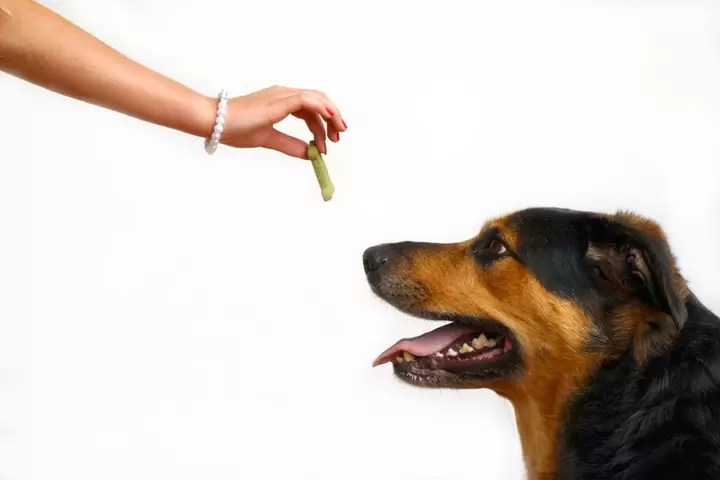Dog treats can be a fun way to bond with our canine companions and reward good behavior. However, there are also some important potential downsides of treats to be aware of in order to keep dogs healthy and happy. This in-depth article will explore several Disadvantages of Dog Treats so owners can make informed choices that don’t compromise their pup’s wellness.
Weight Gain from Too Many Treats
Providing an excess of treats is one of the leading causes of obesity in pet dogs according to the Association for Pet Obesity Prevention . While rewarding our dogs brings them joy in the moment, empty calories from frequent snacks can easily accumulate over time if not monitored.
Puppies and less active dogs are especially vulnerable to piling on extra pounds from treats that displace healthier calories from their daily food. Excess weight puts unnecessary pressure on joints and internal organs, increasing risks for serious health complications. Carrying even a few extra pounds can shorten life expectancy in dogs by up to two years!
A guideline from pet nutrition experts is that no more than 10% of daily calories for dogs should come from treats. But for some dogs, even this amount could promote slow, steady weight gain. It takes careful portion control and attention to prevent treats from sabotaging their calorie balance and causing issues down the line.
Obesity impacts more than just a dog’s physical health excess pounds also reduce quality of life. Activities that were once easy become difficult, increasing risks of injury. Heat intolerance poses challenges. Overall mobility and happiness decrease as extra weight bears down. These risks aren’t worth the temporary pleasure of snacks.
Conscientious pet owners concerned about their dog’s longevity should consult a vet to determine ideal calorie levels based on each dog’s age, size and activity level. Only provide “left over” allotments from regular meals as low calorie treats for training at most, never as constant nibbles throughout the day. With awareness and care, weighty health issues from overly indulgent treats can easily be avoided.
Digestive Upsets from Unhealthy Ingredients
Though dog treats are marketed as edible rewards, not all ingredients are ideal for canine digestion. Common irritants that could induce tummy troubles include:
- Artificial colors and flavors: These synthetic additives have no nutritional value. Dogs may react negatively to dyes and chemicals they are not adapted to digest.
- Grains like wheat and corn: Many dogs have wheat/gluten or corn sensitivities that trigger bloating, gas and loose stools when consumed.
- Soy ingredients: Soy is difficult to digest and a top food allergen for dogs. It frequently causes itching, ear infections and diarrhea if eaten regularly.
- Sugar: Digestive systems are not equipped to break down simple sugars, which easily ferment in the gut producing excess acidity and loose motions.
- Preservatives like BHA, BHT: While meant to prolong shelf life, these unnecessary additives could irritate the digestive lining.
Signs of digestive upset from less than ideal ingredients typically show up as vomiting, soft stools, flatulence or loss of appetite within hours or days of consuming the trigger item. Inflammation of the bowels called colitis has also been linked to artificial colors and sweeteners in dog treats.
It’s always better to select treats made from limited, easy to digest ingredients like chicken, salmon or sweet potatoes that won’t cause internal distress. Carefully checking labels will help avoid trigger foods disguised in “treat” form. An occasional tummy ache isn’t worth the “reward” of harmful additives and fillers.
Spikes in Blood Sugar
Just as excess sugar can compromise human health, it poses risks for canine companions too. Many commercial dog treats rely heavily on sweeteners to make them more tempting but provide zero nutrients. Studies link sky high blood sugar level spikes from sugary snacks to detrimental canine conditions:
- Pancreatitis: Inflammation of the blood sugar regulating pancreas is excruciatingly painful for dogs. It requires medical monitoring. Recurrences can be fatal.
- Diabetes: Constant high blood sugar overwhelms the body’s ability to produce insulin over time. Daily insulin injections and strict diet controls are a lifetime commitment to manage “dog diabetes.”
- Obesity: Calories from sugar are empty providing energy without satiety. Over consumption promotes weight gain beyond needed energy levels.
For a treat to be a responsible choice, it should contain protein, fiber or fat to balance out any natural sugars slowly. These nutrients help glucose enter cells gradually instead of spiking dangerously in the bloodstream. While an occasional fruit sweetened training treat likely won’t cause problems, always read labels closely and avoid excess sugar as the primary ingredient. Balanced nutrition is a priority over empty temptations.
Potential Dental Damage
Crunchy, hard treats are touted as natural tooth cleaners due to the grinding motion. In fact, studies show excessive chewing on abrasive chews and bones does more harm than good according to the Veterinary Dental Forum. While light intermittent chewing between meals safely removes plaque, over reliance leads to enamel wear and fractures:
- Chips and cracks develop in tooth enamel from the compressive force. Enamel does not grow back once damaged.
- Adult dog teeth lack the tough enamel of younger pups. Biting forces weaken mature teeth prone to root exposures and fractures over time from excessive crunchy treats.
- Daily brushing removes surface stains but plaque removal requires mechanical disruption hard chews don’t compare to regular brushing for deep cleaning effectiveness.
- Gum disease flourishes when tartar is ground into pockets by abrasive chewing rather than gently scraped away.
For senior dogs, large or small breed pups prone to fractures, and any dog with existing dental issues, the risks of hard treats outweigh rewards. Opt for gentle chewing actions on less abrasive toys as an alternative that won’t jeopardize long-term dental health.
Unintended Behavior Problems
When treats become the go to reward for basic training, it can condition unwanted behaviors if not used judiciously according to experts. Dog owners may encounter issues like:
- Begging and stealing: Expecting a treat each time people are near leads to nuisance behaviors.
- Inconsistent obedience: Dogs learn commands are optional without food motivation.
- Guarding and aggression: Dogs may feel threatened by others approaching their “high value” treats.
- Hyperactivity: Sugar rushes from constant snacking disrupt calm behaviors.
- Misdirected focus: Dogs pay more attention to the treat than their handler during training.
To avoid these pitfalls, carefully limit rewards only to new behavior introductions until learned. Switch to praise as the primary reinforcement while keeping treats intermittent and valuable. Consistency in technique is more important than relying on foods alone. With moderation and balance, rewards enhance training without risking compliance or health issues.
Food Sensitivities and Allergies
Certain ingredients frequently trigger adverse reactions equivalent to allergies in dogs, causing unpleasant symptoms that diminish quality of life. Top problem foods identified by vets include dairy, beef, chicken, eggs, grains and soy.
Common signs of an allergy to a treat component are:
- Itchy, flaking skin or hot spots
- Red, inflamed ears
- Diarrhea, vomiting or foul smelling anal glands
- Rashes and skin infections
Just as humans may react poorly to specific foods, dogs’ digestive systems vary in tolerance too. Placing a temporary ban on introducing anything new into the diet helps identify triggers causing bothersome flare ups. Hypoallergenic diets and topical remedies provide relief once problematic ingredients are pinpointed. Careful monitoring and management of sensitivities is critical for a furry friend’s wellness.
Soaring Costs over Time
While quality single ingredient treats offer nutrition, dependence on commercial snacks as constant reinforcers affects household budgets over months and years. Though cheaper at point of sale initially, filling treats with fillers, colors and preservatives provide minimal value for growing costs:
- A 15-pound bag of puffed corn and food coloring treats may seem a bargain at $15-20, but empty calories substitute important nutrients in imbalanced diets.
- $5-10 weekly on impulse purchases of 8-10 low grade snacks adds up to $260-520 yearly that displace more beneficial rewards.
- Premium dehydrated or air dried meats provide sustained training value for their higher per piece prices when used judiciously.
- Balanced kibble or veggies from mealtimes make economical alternatives to constant pricey treats.
With discipline, nutritious homemade/bulk rewards and non food praise satisfy training needs more cost effectively than addictive nibbles of filler filled treats promoted heavily via marketing. Wise budgeting protects furry wallets from indulgent expenses with negligible benefit.
Medical Risks of Overindulgence
While moderate treat consumption as an occasional supplement brings joy, some pups’ genetics and environments promote compulsive eating if extras are always available. Over rewarding any natural drive risks serious health consequences according to the Association for Pet Obesity Prevention:
- Obesity catalyzes joint problems, diabetes, cardiovascular strain and even certain deadly cancers.
- Pancreatitis occurs more commonly in dogs carrying extra pounds from fatty diets. Severe cases require intensive care costing thousands of dollars to recover from.
- Dental disease flourishes in the form of severe gingivitis and tooth loss when plaque isn’t adequately disrupted through mechanical brushing or limited hard chews alone.
Veterinarians caution keeping dogs at a healthy weight through measured portioning and exercise is paramount for longevity. While rewards enhance quality bond time together, moderation prevents cut short lives from being overwhelmed by excess consumption indulgences.
Conclusion About Disadvantages of Dog Treats
In moderation as a training supplement, carefully selected occasional treats contribute positively to the human dog relationship. However, overuse poses legitimate wellness disadvantages from weight gain, dental risks, belly upsets, behavior issues, allergies, soaring costs and medical dangers down the line.
By carefully limiting amount provided based on calorie needs, choosing wholesome balanced ingredients, and monitoring for skin/digestive sensitivities, owners empower furry best friends with longevity through preventative lifestyle choices. Obedience comes from praise not food dependency, teeth stay strong from regular brushing not hard munching, and health thrives from balanced moderation not excess bribes.
FAQs
Q:What are the side effects of dog treats?
A:Death, seizures, organ damage
Q:Is it unhealthy to eat dog treats?
A:Definitely watch out for ingredients that are harmful to humans such as BHA, BHT, Ethoxyquin and Propyl Gallate, preservatives often found in dog treats but also known as human carcinogens
Q:Is it safe to make dog treats?
A:A small amount of peanut butter that does not contain xylitol is safe for dogs











